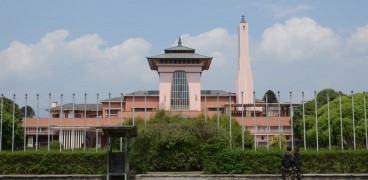Shivapuri Nagarjun National Park also known as Shivapuri National Park is Nepal's ninth national park. The protected area is name after the Shivapuri Peak which has an altitude of 2,732 m (8,963 ft).
The wildlife reserve is home to over 318 species of birds, several mammals, and 2,122 species of flora. Today in this article, we discuss all the natural features of the Shivapuri National Park.
Location of Shivapuri Nagarjun National Park
The Shivapuri National Park lies in the mid-hills of Nepal on the northern side of the Kathmandu Valley. Established in 2002, the park covers a surface area of 159 km sq (61 sq mi) and extends into three districts; Kathmandu, Sindhupalchowk, and Nuwakot. It is further surrounded by a buffer zone of 118.61 km sq.

Map:Shivapuri Nagarjun National Park
credit:dnpwc.com
The park is connected to 23 Village Development Committees of the above districts and parts of it also enter into the Dhading district.
The geographical location of the Nagarjun forest is 85°13' to 85°18' on the East longitude and 27°43' to 27°46' on the North latitude. In contrast, Shivapuri forest lies within 27°45' to 27°52' North latitude and 85°16' to 85°45' East longitude.
The headquarters of the park is situated in Panimuhan village of the Chapali Bhadrakali Village Development Committee of Kathmandu. The headquarters lies at a distance of 12 km away from Kathmandu.
The elevation of the land in the Shivapuri Nagarjun National Park ranges from 1350 masl to 2732 masl.
How can we reach Shivapuri National Park?
The easiest way to get to the park is via road from the capital city. The wildlife reserve lies at a distance of 21.9 km from the heart of Kathmandu and takes about 22 mins in a cab.

View seen by Shivapuri National Park
We can enter the park from Budhanilkantha or Sundarijal.
Origin of Shivapuri Nagarjun National Park
The Shivapuri area has always been the primary source of water for people dwelling in the capital city. The park supplies 30 million litres of drinking water daily.
Owing to its importance the forests of the region was declared as a wildlife reserve and protected watershed in 1976. It was later gazetted as Shivapuri National Park in 2002 with an initial area of 144 km sq.
Later in 2009 the Nagarjun forest covering 15 sq km of land was added to the park.
Before being declared as a national park, the protected area was under the jurisdiction of Shivapuri Watershed Development Board and was called the Shivapuri Watershed and Wildlife Reserve.
The national park has some historical sites which are of religious significance and is also a popular trekking route for tourists.
Weather Conditions of SNNP
The wildlife reserve lies in a transition zone between temperate and subtropical climate. The area experiences an annual rainfall of 1,400 mm (55 in) especially between May and September, which amounts to about 80% during the rainy season.
The national park experiences a temperature of 19–30 °C (66–86 °F) during summer and falls to 2–17 °C (36–63 °F) during winter.
Flora of Shivapuri Nagarjun National Park
The national park is well known for medicinal herbs which grow at higher elevations. According to botanists, the wildlife reserve has recorded the growth of 2,122 species of flora (449 vascular and 16 endemics) and 120 varieties of mushrooms.

Way for Shivapuri Hiking
The forests in the SNNP area are classified into two parts:
- Eastern Himalayan broadleaf forest: Trees of the oak and laurel families along with rhododendron grow on the northern slopes which fall under the lower temperate bioclimatic zone.
- Himalayan subtropical broadleaf forests: Forest with chir pine, wild Himalayan cherry, ring-cupped oak, Engelhardia, and Schima-Castanopis. They grow in the upper and lower subtropical bioclimatic zone.
The distinctive vegetation of the national park is middle hill forest which lies at altitudes ranging between 1,000 to 1,800 (3,300 to 5,900 ft).
Animals found in SNNP
Since its establishment, several surveys have been conducted to study the habitat of animals living in the wildlife reserve. A field conducted between 2003 and 2004 showed the presence of animals like golden jackal, jungle cat, Indian leopard, large Indian civet, small Asian mongoose, wild boar, Hanuman langur, black-naped hare, fawn-coloured mouse, Indian crested porcupine, and many others.
Another study of 2010, trapped the images of leopard cat, masked palm civet, yellow-throated marten, large Indian civet, pangolin, and crab-eating mongoose on camera.
The park is home to over 318 species of raptors like the Eurasian eagle-owl, white-gorgeted flycatcher, golden-throated barbet, slender-billed scimitar-babbler, and barred cuckoo-dove, to name some.
Besides mammals and birds, the wildlife reserve is also home to different species of reptiles and amphibians like Himalayan keelback, Monocled cobra, yellow-bellied worm-eating snake, olive Oriental slender snake, Oriental garden lizard, Sikkim skink, variegated mountain lizard, long-legged cricket frog, and many-keeled grass skink, among many others.
Tourism of Shivapuri Nagarjun National Park
The national park is easily accessible to tourists from Kathmandu who usually visit the place for hiking and trekking.
Trekking routes to places like Gosaikunda, Langtang National Park, Nagarkot, and Helambu pass through the conservation area.

Shivapuri: Cascading Nature's Symphony
Credit: Nepal trekking himalayan.com
Followers of Hindu religion visit Baghdwar and Bishnudwar, origins of sacred rivers Bagmati and Bishnumatii during the Nepalese New Year (mid-April.)
From the northern side of Shivapuri, you can enjoy the spectacular views of the high mountains lying in the Himalayan belt. Further, you can see the panoramic view of the capital city from the southern slopes of the SNNP.
Things to do in Shivapuri Nagarjun National Park
- Enjoy hiking in the Shivapuri National Park
- Visit Kopan Monastery
- Visit Budhanilkantha/Narayanthan Temple
- Trek to Nagarkot, Langtang National Park, Gosaikunda, and Helambu.
For further information on national parks in Nepal, visit Hopnepal.com.







